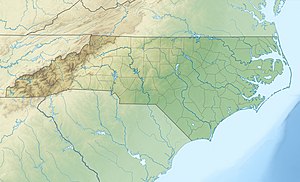Hares Branch
| Hares Branch Tributary to Worrell Mill Swamp | |
|---|---|
| Location | |
| Country | United States |
| State | North Carolina |
| County | Hertford |
| Town | Murfreesboro |
| Physical characteristics | |
| Source | Panther Swamp divide |
| • location | about 0.5 miles south of Murfreesboro, North Carolina |
| • coordinates | 36°25′32″N 077°06′55″W / 36.42556°N 77.11528°W[1] |
| • elevation | 88 ft (27 m)[2] |
| Mouth | Worrell Millpond |
• location | Murfreesboro, North Carolina |
• coordinates | 36°26′10″N 077°05′15″W / 36.43611°N 77.08750°W[1] |
• elevation | 22 ft (6.7 m)[3] |
| Length | 2.85 mi (4.59 km)[4] |
| Basin size | 3.49 square miles (9.0 km2)[5] |
| Discharge | |
| • location | Worrell Millpond |
| • average | 4.66 cu ft/s (0.132 m3/s) at mouth with Worrell Millpond[5] |
| Basin features | |
| Progression | generally northeast[4] |
| River system | Chowan River |
| Tributaries | |
| • left | College Branch |
| • right | unnamed tributaries |
| Waterbodies | Worrell Millpond |
| Bridges | US 158 (x3), Chowan College Road, NC 11 |
Hares Branch is a 2.85 mi (4.59 km) long 2nd order tributary to the Worrell Mill Swamp via Worrell Millpond in Hertford County, North Carolina. This is the only stream of this name in the United States.[1]
Course
[edit]Hares Branch rises on the Panther Swamp divide about 0.5 miles south of Murfreesboro, North Carolina, and then flows northeasterly to join Worrell Mill Swamp on the east side of Murfreesboro.[3]
Watershed
[edit]Hares Branch drains 3.49 square miles (9.0 km2) of area, receives about 48.3 in/year of precipitation, has a wetness index of 515.21, and is about 23% forested.[5]
See also
[edit]References
[edit]- ^ a b c "GNIS Detail - Hares Branch". geonames.usgs.gov. US Geological Survey. Retrieved 19 May 2021.
- ^ "Get Maps". USGS Topoview. US Geological Survey. Retrieved 19 May 2021.
- ^ a b "Get Maps". USGS Topoview. US Geological Survey. Retrieved 19 May 2021.
- ^ a b "ArcGIS Web Application". epa.maps.arcgis.com. US EPA. Retrieved 19 May 2021.
- ^ a b c "Hares Branch Watershed Report". US EPA Geoviewer. US EPA. Retrieved 19 May 2021.


 French
French Deutsch
Deutsch
